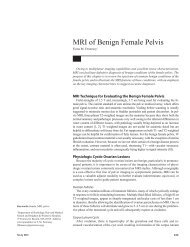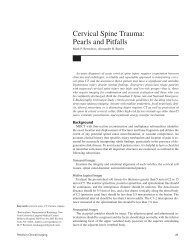Scientific Session 1 â Breast Imaging: Mammography
Scientific Session 1 â Breast Imaging: Mammography
Scientific Session 1 â Breast Imaging: Mammography
Create successful ePaper yourself
Turn your PDF publications into a flip-book with our unique Google optimized e-Paper software.
<strong>Scientific</strong> <strong>Session</strong> 5—Informatics, Quality, Safety, and PolicyMonday<strong>Scientific</strong> <strong>Session</strong> 5 — Informatics,Quality, Safety, and PolicyMonday, May 2, 2011Abstracts 034-043034. Automated PACS Retrieval and Processing of Dose Data FromLegacy CT SystemsCheng, P.* University of Southern California, Los Angeles, CAAddress correspondence to P. Cheng (phillip.cheng@usc.edu)Objective: Although DICOM standards have been developed for structuredencoding of CT dose data, legacy CT systems continue to encodepatient dose information as screen capture bitmaps not directly amenableto automated retrieval and processing. In addition, each CT manufacturerpresents dose information using different nonstandardized tabular formatsand fonts. We have built a system that can acquire and decode thisheterogeneous CT dose information from the PACS and incorporate itinto a database for data mining and monitoring.Materials and Methods: Four bitmap character fonts were constructed fromdose screens of Toshiba, General Electric, Siemens, and Philips CT scanners.An exact glyph matching algorithm was implemented in C# to convertscreen capture data into raw text. A separate subsystem queries our FujiSynapse PACS database for CT screen capture data using HTTP-wrappedSQL statements. Retrieved DICOM dose data is processed using the characterrecognition algorithm and parsed for dose statistics, including dose-lengthproduct (DLP). The dose data and patient demographics are incorporatedinto an SQLite database, with summary statistics and graphs automaticallygenerated by scripts in the R statistical environment. The entire retrieval,decoding, database, and analysis system runs portably from a USB drive onany PACS workstation, without altering client or server configuration.Results: Using this system, dose data have been processed from 3171 CT studiesof the abdomen performed at University Hospital, Norris Cancer Center,and Healthcare Consultation Center II at the University of Southern Californiabetween July 2009 and September 2010. The system has been successfullyused to detect dose outliers for further analysis, and to compare dose profiles ofdifferent CT machines. Several limitations are the subject of further development,most importantly the normalization of DLP values for body size. Otherinformatics issues discovered include incorrect or insufficiently specific procedurecodes for some CT studies, and problems of separability of dose data fordifferent body regions such as the chest and abdomen.Conclusion: Heterogeneous screen capture dose data in PACS from differentCT scanner manufacturers can be automatically retrieved and processedfor retrospective data mining and monitoring.035. Open Source Software for Monitoring CT DosageLaks, M.* Montefiore Medical Center, Flushing, NYAddress correspondence to M. Laks (mlaks2000@yahoo.com)Objective: Increased international attention to diagnostic radiology radiationdosage has spurred interest in monitoring the patient dosage of radiation indiagnostic radiology departments. CT examination dosage is a major contributorycomponent of diagnostic radiation. A few groups have developedand described software to monitor CT dosages in patients at their institutions,using optical character recognition (OCR). Our institution has a mixture ofCT machines from multiple vendors and the methods described by thoseother institutions are not applicable in our environment, as some vendors donot report radiation dosage for CT series in image format.Materials and Methods: For our institution we developed an open sourceapplication, Ezekiel Dose, and we make it available in open source format.We developed the application on the Linux platform, using Perl, and the opensource DICOM libraries dcmtk and dcm4che, open source OCR and imagemanipulation tools and the open source relational database Postgresql,that enables us to calculate and store monitor radiation dosage in CT atMontefiore Medical Center. Montefiore Medical Center has a heterogenousmixture of CT machines from multiple vendors (GE, Siemens, and Philips)Our Philips equipment does not currently display radiation dosage for CTseries in image format as displayed by the GE and Siemens equipment.Results: Our software uses direct calculation of radiation from DICOMheader data or OCR if available to determine radiation dosage for CTexaminations. We describe the software we have developed and the techniquethat we use to obtain the data from the medical center enterprisePACS. Our application resides on a stand-alone PC and communicateswith the PACs using the open source dcmtk software toolkit. We haveutilized Ezekiel Dose to perform quality assurance functions in our departmentand assure that the patient doses do not exceed guidelines. Ourapplication is available as an open source application.Conclusion: Ezekiel Dose is an open source application that we have createdto monitor the radiation dosages at our medical center. It is of great help inour departmental radiation dose quality assurance program. The power ofproviding the software in open source format is to enable collaborative sharingand enable other institutions to utilize, customize, and further developthis software to meet their radiation safety needs. This will help us to achieveour common goal to provide a safe radiation environment for our patients.036. Will CT Ordering Practices Change if We Educate Clinicianson CT Radiation?Horowitz, J.*; Miller, F.; Casalino, D.; Omar, I.; Yaghmai, V.Northwestern University, Chicago, ILAddress correspondence to J. Horowitz (jhorowitz77@gmail.com)Objective: The purpose of this study is to determine if educating cliniciansabout radiation alters CT scan ordering.Materials and Methods: After a lecture on CT radiation, clinical housestaff was surveyed regarding the amount and type of CT scans orderedand use of alternative imaging modalities before and after a lecture andwhether they used lecture information to educate patients.Results: Twenty-one clinical house staff who attended the lecture completedthe survey either 2 or 4 months after the lecture. The amount ofCT scans ordered after the lecture stayed constant for 90% of respondentsand decreased for 10%. The types of CT scans ordered changed after thelecture for 14% of respondents. Thirty-three percent of all respondentsreported an increase in use of alternative imaging after the lecture, including24% increase in MRI and 19% increase in ultrasound. Twentyninepercent of respondents reported that patients had asked them aboutA14*Will present paper
















